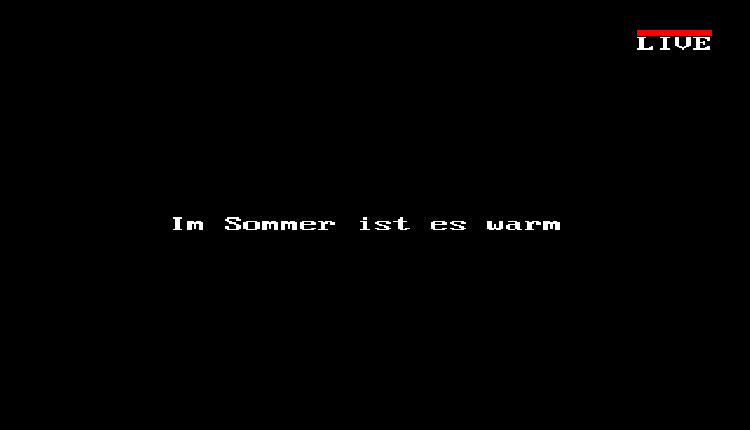Teletext pages
International Teletext Art Festival ITAF2013 ITAF is a International Teletext Art Festival made in collaboration with FixC cooperative and ARD Text, ORF TELETEXT and SwissTXT. https://teletextart.com/pages/artists_works.html
Broadcasts
– Live on Teletext for 15 days @ ARD, ORF and SwissTXT
– ARD Hauptstadtstudio Exhibition Space, Berlin
– Deep Space Centers, Ars Electronica Festival 2013, Linz
Teletext Art Between Past and Future
On the top page of the Teletext Museum on the internet there is a picture of a teletext screen with the following statement: “Dear Viewer, By the time you read this, I will be dead. When I started out in 1974, I was the future – TV’s first robot newsreader. But what once seemed cutting-edge is now regarded as hopelessly old-fashioned, and I have been frozen out by powers that be, yet another victim of BBC ageism. I can’t take it any more. It’s a struggle to get up for the nightshift, and my poor pixels are tired. My friend Oracle said it would end like this. Goodbye, cruel world.” The time is Sun 21 Oct [2012], 23:56. The banner at the bottom still declares: “Ceefax: The world at your fingertips.”
This is one of those mementos that mark a technological death, the sudden disappearance of a medium that had become a household item, a kind of simulated friend, for countless users over the years. All of a sudden, it was no more. Other channels would take its place, but something had changed. Although I still have not figured out if this perfectly worded message is genuine or staged for the purpose of announcing the death of a medium and its rebirth as a museum, the referent was real: the closing of Ceefax (“see facts”), BBC’s teletext service that had operated continuous since 1974. It had fallen victim to digitalization and competition from internet-based news service. Oracle was a similar service from the Independent Television Authority (ITA). Its career had already ended with the year 1992.
The message did not signal the ultimate end of a medium that then had had a lifespan of not quite two decades. It still survives and is eagerly consulted in many places on the planet. I just read the headlines of the Finnish Teksti-TV, relayed through the internet – I am in Los Angeles. Still, there is a feeling that its days are little by little numbered. I am not a believer in “dead media.” What I see happening is media forms merging with each other and a new ones taking the place of older ones, emulating their qualities. Media’s death is relative. Still, in some cases it feels almost real. I still keep some birthday telegrams I received from my aunt who lives in Munich when I was a boy. There was something solemn in their arrival. She could not do it anymore even if she wanted. She could send me a Twitter message but that would not feel the same.
Teletext does not seem to have inspired much media archaeological research even though it would be a suitable topic. Perhaps that has been partly caused by its in-between status: not quite gone but not fully present either. Artists have been more active, as we can see from the works exhibited at the Teletext Art Festivals. The challenge is interesting, and has to do with the peculiar nature of the medium. When teletext was invented in the early 1970s, it was designed as an adjunct to analog broadcast television. Television’s program flow was still dominated by its traditional pseudo-live mode, with talking heads addressing the spectators directly. In-between their appearances there were various other types of programming, much of it in the indirect mode of address familiar from narrative cinema. The characters of television series talked to each other without acknowledging the presence of the spectators in front of the screen. Certainly there were also hosted programs and advertisements, but one aspect was absent: television was not a medium for graphic and textual representation. The texts that could be seen on the screen normally played secondary roles for the images and sounds.
This is the situation teletext came to amend. It was a source of information that eschewed talking heads and concentrated on text pages and basic graphics. It was an electronic books of sorts, a novelty long before e-books and webpages. Although it originated in England, there were parallel versions were developed in other countries. There were also related media like the French Minitel, which, instead of being a feature added to broadcast television, refunctionalized the telephone, turning it into a suprisingly versatile interactive information retrieval and transmission system. Some teletext systems had pages scrolling at timed intervals, which left the spectator waiting for the needed information. Other systems, like the Finnish Teksti TV, had a feedback system through the remote controller, at least from the early 1990s on. The pages on the screen were all related to a number; typing it on the remote controller rapidly retrieved the requested page. The supply consisted of hundreds of pages and was updated frequently. In those days Teksti TV was often more useful for me that the traditional program flow, because the needed information always there, waiting for me. This was before the PC connected to a modem began changing things.
Teletext was born as a limited bandwidth medium for a certain purpose. What it did took place within strictly defined but logical parameters. The best way to add information was to stack more pages into the system, making the book on-line grow. As far as I know, art was not raised as one of the potential uses. Perhaps that is exactly one of the reasons that began drawing artists towards it. Contemporary artists have one peculiar quality; they can draw inspiration from anything. The poverty of initial means of expression may lead to maximizing the output. Limited ingredients can be exciting, and certainly resonate with the goals of conceptualism and arte povera. Perhaps it should be said that conceptually teletext is not at all limited when it comes to the possibilities of minimalist graphics and its nature as an information channel. The richness of possibilities emerges from stretching the contents of a limited toolkit. There is something similar in the fascination of early 8-bit game graphics for some artists; a retro-spirit is also an element of both.
Now that the future of teletext as a day to day medium seems in decline, it is predictable that artists working with this medium will develop an even more self-reflective meta-attitude. Jodi-org’s work already points to that direction. The medium will develop a cultural memory for itself. It will include reflections on its formal qualities and coding principles. Just as in events were game graphic -inspired media art is exhibited, at Teletext Art Festivals we have already witnessed the emergence of such a self-conscious attitude. But although future teletext art will be about teletext and most likely about teletext art as well, it will probably also be about something else. It may be worth having a peek at what artists like Christian Marclay have been doing with vinyl LP’s which for a while seemed to have turned into a dead medium, only good for hardcore collectors, hip-hop DJ’s and archaeologically oriented artists. Marclay has used LP records in many ways: as sound sources, material collages, “bricks” for room installations, even fan-like rhythm instruments. While this was happened, the vinyl record has made a comeback as a saleable and collectable product, while the CD has been at least seemingly on the way towards oblivion for several years now.
I cannot predict what is at store for teletext art in the near future. It is possible that much of it has to gradually migrate into other contexts, most obviously to the internet. That gives it potentially a wider audience, but entirely losing the genuine channel out of which it as an artistic medium emerged would be a pity. Time will tell. Could there be a teletext service dedicated solely for art, or could one of the existing services give it a permanent home? Time will tell. What is certain is that initiatives like the Teletext Art Festival are badly needed. Even as its forms are multiplying, the realm of media culture is becoming more predictable, centered on safe and sound familiar formulas. We need new forms and ideas, from the past as well as from the future, to stir the minds and to break the spell of uniformity. Teletext art can be like a fresh breath from the unknown. I cannot see it ever gaining mainstream acceptance, but being at the fringe is not necessarily a bad thing because it gives room to breathe and to think about new strategies and approaches. I will be following the new developments on this field with great curiosity.
Text: Erkki Huhtamo Media Archaeologist, Historian, Exhibition Curator


